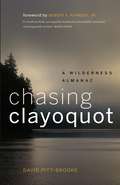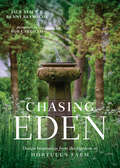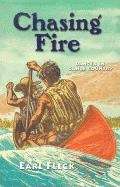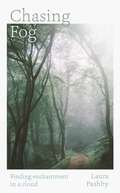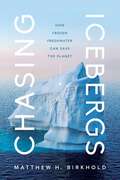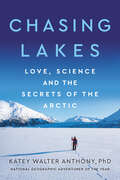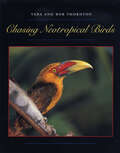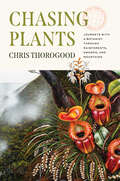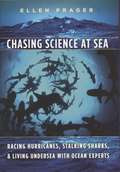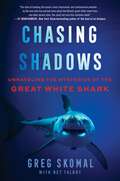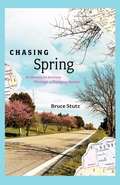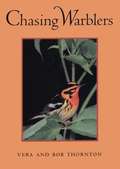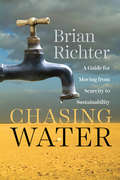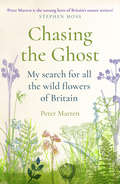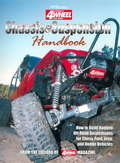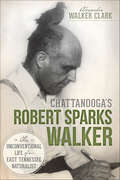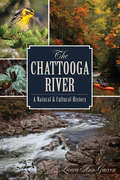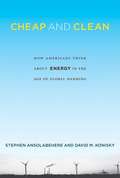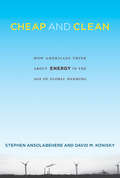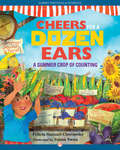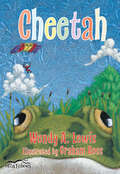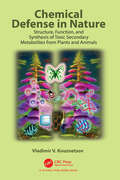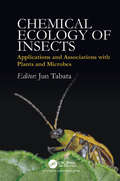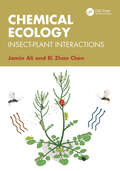- Table View
- List View
Chasing Clayoquot
by Robert F. Kennedy Jr. David Pitt-BrookeFirst published in 2004, and now with a new introduction by the author and a foreword by Robert F. Kennedy Jr., this book of natural history, environmentalism, and politics explores one of the Earth's last primeval places: Clayoquot Sound. Pitt-Brooke takes the reader on 12 journeys, one for each month of the year. Each journey covers the outstanding natural event of that season, such as whale-watching in April, shorebird migration in May, and the salmon spawn in October.
Chasing Eden: Design Inspiration from the Gardens at Hortulus Farm
by Jack Staub Renny Reynolds&“Vision, tenacity, and a perfectionist&’s eye are the qualities that shine out from this account of a paradise garden created by two of America&’s foremost stylists.&” —Anna Pavord, author of The Curious Gardener and Landskipping One of the most spectacular private gardens in America, Hortulus Farm is the masterpiece of Renny Reynolds and Jack Staub, renowned experts in the fields of design, gardening, and entertaining. It is beautifully captured in Chasing Eden, a lavishly illustrated roadmap to creating a personal Eden. Hortulus Farm is a not only a model of classical tenets, but also a showcase of how traditions can be successfully broken. Gardeners will discover information on specific design principles, from vistas and allées to hardscaping and water features. They will also learn how to adapt these principles to less-than-optimal settings without sacrificing a site&’s sense of place. Both aspirational and practical, Chasing Eden will inspire home gardeners to create their own earthly paradise.
Chasing Fire: Danger in Canoe Country
by Earl Fleck'Fire Danger High' reads the sign at the US Forest Service ranger station as thirteen-year-old Danny Forester returns to the Boundary Waters Canoe Area Wilderness for another family canoe trip adventure. He is a year older, taller, and more skilled. Still, the unpredictable events of the trail test his courage and endurance. Early on, he helps his family rescue another family, the Tuckers from Ohio, who have swamped on huge windswept Lake Lac La Coix. Then, on a risky night paddle, the Foresters leave the Tuckers, including thirteen-year-old Julie Tucker, to a Canadian ranger station for emergency medical evaluation. Despite the exhausting rescue and increasing fire danger, Danny and his family are still able to follow their planned route through canoe country. They discover an enormous beaver dam and lodge, spot a bull moose feeding, sight a bald eagle, and hear loons singing through the night. Danny's younger sister, Rachel, photographs nature, tape-records birdsongs and teases her brother about the attention he has paid to Julie Tucker. Danny's older brother, Mike, is off fighting forest fires, protecting the BWCAW, when he meets up with his family. Danny tests his skill and courage by camping out "solo" on Bear Island on the last night of the trip. In the dramatic conclusion, Danny draws upon great reserves of inner strength to face the danger of a raging forest fire and save his family. Chapter illustrations by the author convey the essence of this exciting story. Earl Fleck has camped for over thirty years in the BWCAW and Quetico wilderness regions. A psychologist in private practice and an investigator for the Minnesota State Attorney General's Office, he lives with his family near Minneapolis, Minnesota. Also Available by Earl Fleck 'Chasing Bears: A Canoe Country Adventure' TP $12. 95, 0-930100-90-5 - CUSA
Chasing Fog: Finding Enchantment in a Cloud
by Laura PashbyAt first, I didn&’t find fog – fog found me. Liminal, transformative and increasingly elusive – far from a simple cloud of water droplets, fog is a state of mind. As mist drifted through a copse of trees, turning a familiar place strange and otherworldly, Laura Pashby snapped a photograph and an obsession began. Pashby hunts for fog, walks and swims in it, explores its often pivotal role in literature, mythology and history, as well as its environmental significance. There has been a 50 per cent drop in 'fog events' in the past fifty years, fog is drifting away without us noticing and the ecological impact could be calamitous. As she journeys to the foggiest places she can find, Pashby immerses herself in Dartmoor&’s dangerous fog, searches for the Scottish haar, experiences Venice&’s magical mist, tell us the myths behind the River Severn&’s fog and the shipwrecks it hides. It&’s easy to get lost in fog, but sometimes it&’s where imperceptible things can be found, including in ourselves. Chasing Fog is a captivating meditation on fog and mist, a love song to weather and nature&’s power to transform.
Chasing Icebergs: How Frozen Freshwater Can Save the Planet
by Matthew H. BirkholdA deeply intelligent and engrossing narrative that will transform our relationship with water and how we view climate change.The global water crisis is upon us. 1 in 3 people do not have access to safe drinking water; nearly 1 million people die each year as a result. Even in places with adequate freshwater, pollution and poor infrastructure have left residents without basic water security. Luckily, there is a solution to this crisis where we least expect it. Icebergs—frozen mountains of freshwater—are more than a symbol of climate change. In his spellbinding Chasing Icebergs, Matthew Birkhold argues the glistening leviathans of the ocean may very well hold the key to saving the planet. Harvesting icebergs for drinking water is not a new idea. But for the first time in human history, doing so on a massive global scale is both increasingly feasible and necessary for our survival. Chasing Icebergs delivers a kaleidoscopic history of humans&’ relationship with icebergs, and offers an urgent assessment of the technological, cultural, and legal obstacles we must overcome to harness this freshwater resource. Birkhold takes readers around the globe, introducing them to a colorful cast of characters with wildly different ideas about how (and if) humans should use icebergs. Sturdy bureaucrats committed to avoiding another Titanic square off against &“iceberg cowboys&” who wrangle the frozen beasts for profit. Entrepreneurs selling luxury iceberg water for an eye-popping price clash with fearless humanitarians trying to tow icebergs across the globe to eradicate water shortages. Along the way, we meet some of the world&’s most renowned scientists to determine how industrial-scale iceberg harvesting could affect the oceans and the poles. And we see firsthand the looming conflict between Indigenous peoples like the Greenlandic Inuit with claims to icebergs and the private corporations that stand to reap massive profits. As Birkhold shepherds readers from Connecticut to South Africa, from Newfoundland to Norway, to Greenland and beyond, he unfurls a visionary argument for cooperation over conflict. It&’s not too late for icebergs to save humanity. But we must act fast to form a coalition of scientists, visionaries, engineers, lawyers and diplomats to ensure that the &“Cold Rush&” doesn&’t become a free-for-all.
Chasing Lakes: Love, Science, and the Secrets of the Arctic
by Katey Walter AnthonyAn aquatic ecologist and permafrost scientist recalls her captivating adventures across the Arctic studying climate change, her quest to find belonging and family, and her journey of faith in a world of science in this poignant, eye-opening, and hopeful memoir in the spirit of Lab Girl, Educated, and Finding the Mother Tree.Katey Walter Anthony’s enchantment with lakes began when she was growing up amid the Sierra Nevada mountains. Today, her love for these bodies of water have taken her to the deepest reaches of Alaska and Siberia, where she is undertaking pioneering research on methane emissions. Chasing Lakes is her story: one-part adventure—complete with shipwrecks and treacherous treks through Arctic storms by helicopter, snowmobile, and foot to measure greenhouse gases—part coming-of-age tale, as she searches for belonging in the wake of a broken childhood, and part spiritual quest to find a wholeness science cannot fill.Somewhere between the remote, frozen landscapes of Siberia and her rough cabin in Alaska, she discovers her spiritual and emotional home when she meets Peter, a bright and humble Minnesota farmer who reinvigorates her faith and helps ground her. Yet finding love and fulfillment brings its own challenges. The closer she gets to having the family she’s always wanted, the further she’s pushed from the important field work that is her passion.Chasing Lakes is a chronicle of a woman seeking truth, adventure, scientific discovery, family, love, and grace. Both an eye-opening look from the frontlines of the climate crisis and an intimate portrait of a brilliant scientist, Chasing Lakes is memoir writing at its finest: beautiful, complex, revelatory, and moving.
Chasing Neotropical Birds (Corrie Herring Hooks Series)
by Vera Thornton Bob Thornton&“This book is for anyone who loves nature photography or birding . . . A fine introduction to the beauty and diversity of this region.&” —Southeastern Naturalist From Belize to Brazil, the forests of the American neotropics are home to an astonishing array of birds—over 3,700 different species, or nearly forty percent of all the birds on earth. Birding enthusiasts Vera and Bob Thornton have spent fifteen years photographing these special and exotic birds in the rainforests of eleven different countries of Central and South America. In this book, you&’ll find more than a hundred spectacular color photographs they took during their travels, along with a highly entertaining account of their adventures—and misadventures—in chasing these exotic neotropicals. The birds pictured here are among the Thorntons&’ personal favorites—birds that, in their words, &“either dazzled us with their beauty, or charmed us by their behavior, or, in a few cases, simply challenged us by the mystique of their rarity.&” This latter category includes such elusive and sought-after birds as the Black-crowned Antpitta, the Zigzag Heron, the Rufous-vented Ground-Cuckoo, the Bare-necked Umbrellabird, and the monkey-eating Harpy Eagle. In the accompanying text, Bob Thornton engagingly describes the challenges as well as the magic of negotiating the neotropical rainforests in search of colorful birds to photograph. For those who would like to follow in the Thorntons&’ footsteps, there are also helpful tips about photographic gear and techniques, preferred places to see the birds, lodging, and guides. For everyone who enjoys excellent nature photography, Chasing Neotropical Birds is a must-have volume.
Chasing Plants: Journeys with a Botanist through Rainforests, Swamps, and Mountains
by Chris ThorogoodA New Scientist Best Book of the Year From an acclaimed botanist and artist, a thrilling and beautifully illustrated expedition around the globe in search of the world’s most extraordinary plants. After making a strange discovery on a childhood trip to Ikea—a stand of sap-sucking, leafless broomrapes, stealing nutrients from their neighbors’ roots—Chris Thorogood dreamed of becoming a botanist and would stop at nothing to feed his growing addiction to plants. In his hair-raising adventures across Europe, Africa, the Middle East, and Asia, Thorogood treads a death-defying path over cliffs, up erupting volcanoes, through typhoons, and out into the very heart of the world’s vast, green wilderness. Along the way, he encounters pitcher plants, irises, and orchids more heart-piercingly beautiful than could ever be imagined. But with Thorogood as our guide in Chasing Plants, we not only imagine: we see. An internationally acclaimed botanical illustrator, Thorogood conjures his adventures spent seed-collecting and conserving plants around the world back to life in his electric paintings, which feature throughout the book. They bring plants out of the shadows, challenging us to see their intrigue and their character, and helping us to understand why plant species must be protected. To join Thorogood in his wild adventures is to be cast under his green spell: readers will never think of plants the same way again.
Chasing Science at Sea: Racing Hurricanes, Stalking Sharks, and Living Undersea with Ocean Experts
by Ellen PragerTo the average office-dweller, marine scientists seem to have the good life: cruising at sea for weeks at a time, swimming in warm coastal waters, living in tropical paradises. But ocean scientists who go to sea will tell you that it is no vacation. Creature comforts are few and the obstacles seemingly insurmountable, yet an abundance of wonder and discovery still awaits those who take to the ocean. With passion and wit, well-known marine scientist Ellen Prager shares her stories as well as those of her colleagues, revealing that in the field ingenuity and a good sense of humor are as essential as water, sunblock, and a GPS. Serendipity is invaluable, and while collecting data is the goal, sometimes just getting back to shore means success. But despite the physical hardship and emotional duress that come with the work, optimism and adventure prompt a particularly hardy species of scientist to return again and again to the sea. Filled with firsthand accounts of the challenges and triumphs of dealing with the extreme forces of nature and the unpredictable world of the ocean, "Chasing Science at Sea" is a unique glimpse below the water line at what it is like and why it is important to study, explore, and spend time in one of our planet's most fascinating and foreign environments.
Chasing Shadows: My Life Tracking the Great White Shark
by Greg Skomal Ret Talbot“At last: the story of tracking the ocean’s most charismatic and controversial predator, compellingly told by the man who has learned more about the Atlantic great white shark than any other person alive. You must not miss this fantastic book!” —Sy Montgomery, New York Times bestselling author of The Soul of an OctopusDr. Greg Skomal, one of the leading great white shark experts in the country, reveals the true nature of these mysterious apex predators, as well as the fascinating story behind their history and startling resurgence With its quaint villages, local restaurants serving up lobster rolls, and miles and miles of warm, sandy beaches, Cape Cod, Massachusetts, is famous for being America’s carefree seaside getaway. But in August 2012, the first confirmed white shark attack in almost eighty years occurred in the region. As shark sightings quickly began to increase on Cape Cod and elsewhere, and large beachside billboards warning about the growing shark population became a common sight, a boogie boarder died after being attacked by a great white shark in Cape Cod’s shallow waters. What had changed to cause news of human-shark interactions to go from being a rarity to being the new normal? As some citizens called for shark culls, nets, drone surveillance, and other extreme solutions, interactions between local residents and scientists, politicians, and those responsible for public safety became tense and frantic. Dr. Greg Skomal, a shark biologist whose lifelong passion has been to gain a more refined understanding of great white sharks, was at the center of it all. This is the story of the great white shark’s return to the eastern seaboard, told through the life of the scientist who found himself in the oftentimes thankless position of having to balance conservation efforts and the drive to do important science with panic and fear in the court of public opinion. Greg has spent decades on a quest to tag, track, and demystify this animal, using every high- and low-tech method at his disposal, including those he invented, and he frequently comes face-to-face with these shadows of the deep. He leaves no stone unturned in his pursuit of the secrets behind the largely unknown lives of these charismatic creatures and in his duty to solve the intricate puzzle of how humans can coexist alongside them. Chasing Shadows is a too-rare conservation success story about restoring an apex predator to an ecosystem that provides a profound, new understanding of a beast so notoriously fierce that it’s nearly impossible to imagine how vulnerable it truly is.
Chasing Spring: An American Journey Through a Changing Season
by Bruce StutzIn the tradition of Blue Highways and Silent Spring, Chasing Spring follows nature's season of renewal even as it shows how the delicate mechanisms of spring are increasingly endangered by climate change. Seeking to revive his body and soul following heart surgery, acclaimed nature writer Bruce Stutz set out on a three-month journey through the unfolding of an American spring. Driving across the country in a twenty-year-old Chevy sedan, Stutz shows readers that spring is not so much a progression as an arousal; each added minute of the lengthening days and lingering sun brings yet another transformation in the greening landscape as well as in the human spirit. Beginning with the season's southernmost stirrings along the Gulf of Mexico, Stutz sees the first blooms and partakes in the season's festivals -- celebrations with ancient origins that still speak to our wonder at nature's annual rebirth. He follows the migrations of birds northward, the return of life to the forests, and the quickening of snowmelt in the Rockies. He moves across the southern desert, encountering the explosion of cacti and wildflowers and the violence of tornadoes on the drought-stricken Great Plains. He then travels north through the national parks of the West, finally celebrating his journey's end by basking at the solstice amid the beauty of the Alaskan Arctic's twenty-four hours of daylight. Along the way, he accompanies scientists into the field to study the season's changes and meets farmers, Arctic natives, and even migrant mushroom pickers whose livelihoods depend on the coming of spring. In each location, as he observes the sensitive interplay of light and warmth that draws animals, plants, water, and even the soil itself into the biological ballet that makes for the profound stirring we call spring, he also finds that climate change now threatens the basic processes of nature. A moving and thought-provoking record of the year¹s most invigorating season, Chasing Spring is a timely reminder that as trees bud and flowers bloom, the human spirit reawakens as well. Anyone who has ever marveled at spring¹s wondrous transformations?from a first garden blossom to a world in full flower?will find in Chasing Spring a journey to savor.
Chasing Warblers
by Vera Thornton Bob ThorntonKnown to many as "the butterflies of the bird world," wood warblers allure even the most experienced and discriminating birders. Their annual migrations to and from nesting areas in the United States and Canada draw thousands of birders to places such as High Island, Texas; Crane Creek, Ohio; and Point Pelee, Ontario, where warblers stop to rest and feed during the long journey. There birders have a chance to see and photograph these colorful, elusive songbirds whose quick, darting flight among high branches and thick cover makes them some of the most challenging birds to observe and identify. In this entertaining, beautifully illustrated book, Bob Thornton recounts his and Vera Thornton's cross-continent adventures in finding and photographing all 52 species of wood warblers that nest in the United States. In addition to describing where and how they photographed each species, Thornton tells marvelous stories of the colorful characters they encountered along the way. He also touches on the current human threats to wood warblers that come from loss of habitat.
Chasing Water: A Guide for Moving from Scarcity to Sustainability
by Brian RichterWater scarcity is spreading and intensifying in many regions of the world, with dire consequences for local communities, economies, and freshwater ecosystems. Current approaches tend to rely on policies crafted at the state or national level, which on their own have proved insufficient to arrest water scarcity. To be durable and effective, water plans must be informed by the culture, economics, and varied needs of affected community members. International water expert Brian Richter argues that sustainable water sharing in the twenty-first century can only happen through open, democratic dialogue and local collective action. In Chasing Water, Richter tells a cohesive and complete story of water scarcity: where it is happening, what is causing it, and how it can be addressed. Through his engaging and nontechnical style, he strips away the complexities of water management to its bare essentials, providing information and practical examples that will empower community leaders, activists, and students to develop successful and long-lasting water programs. Chasing Water will provide local stakeholders with the tools and knowledge they need to take an active role in the watershed-based planning and implementation that are essential for water supplies to remain sustainable in perpetuity.
Chasing the Ghost: My Search for all the Wild Flowers of Britain
by Peter Marren**ONE OF THE GUARDIAN’S BEST BOOKS OF 2018**Join renowned naturalist Peter Marren on an exciting quest to see every species of wild plant native to Britain.The mysterious Ghost Orchid blooms in near darkness among rotting leaves on the forest floor. It blends into the background to the point of invisibility, yet glows, pale and ghostly. The ultimate grail of flower hunters, it has been spotted only once in the past twenty-five years. Its few flowers have a deathly pallor and are said to smell of over-ripe bananas. Peter Marren has been a devoted flower finder all his life. While the Ghost Orchid offers the toughest challenge of any wild plant, there were fifty more British species Peter had yet to see, having ticked off the first 1,400 rummaging in hedges, slipping down gullies and peering in peat bogs. But he set himself the goal of finding the remaining fifty in a single summer. As it turned out, the wettest summer in years. This expert and emotional journey takes Peter the length and the breadth of the British Isles, from the dripping ancient woods of the New Forest to the storm-lashed cliffs of Sutherland. He paddles in lakes, clambers up cliffs in mist and rain, and walks several hundred miles, but does he manage to find them all? Partly about plants, partly autobiography, Chasing the Ghost is also a reminder that to engage with wild flowers, all we need to do is look around us and enjoy what we see. Praise for Chasing the Ghost:‘Peter Marren is the unsung hero of Britain’s nature writers’ Stephen Moss, author of Dynasties‘Jolly, quixotic and ends with real poignancy’ Guardian ‘A poignant reminder to us all to engage with the wild flowers that grow around us’ i Newspaper
Chassis & Suspension Handbook HP1406
by Carl MunroeChassis and suspension modifications for Chevy, Ford, Jeep and Dodge trucks. Includes sections on lift kits, shocks, springs, chassis modifications for off-road use, tires and wheels.
Chattanooga's Robert Sparks Walker: The Unconventional Life of an East Tennessee Naturalist (Natural History)
by Alexandra Walker ClarkThe legend that was Robert Sparks Walker began in a log cabin outside Chattanooga called Spring Frog Cabin, a humble abode built by a Cherokee naturalist in 1750. Walker would continue in the footsteps of that Cherokee to become synonymous both with Chattanooga and nature, penning thousands of articles, poems and books as a naturalist. Nominated for a Pulitzer Prize, Walker gained international fame for his work, yet his largest impact remains in his native Tennessee. He helped to found the Chattanooga Audubon Society, including preserving his childhood home through Audubon Acres. Walker is remembered throughout the state for his nationally syndicated nature column, and the Lifetime Achievement Award for Environmental Stewardship is given in his name. His life was one of adventure, reflection and a deep devotion to the understanding and preservation of nature. Local author Alexandra Walker Clark, granddaughter of Robert Sparks Walker, celebrates the life of this Scenic City pioneer.
Chattooga River, The: A Natural and Cultural History (Natural History)
by Laura Ann GarrenThe Chattooga River has run through the American consciousness since the movie "Deliverance" thrust it into the national spotlight. But this National Wild and Scenic River is much more than the make-believe set of a suburbanite nightmare. People travel from all over the country to run its rapids, cast into its current for trout and hike the miles of trails that meander through thousands of acres of woods in the Chattooga watershed. One of the last free-flowing rivers in the Southeast, the river muscles fifty-seven miles through a southern deciduous forest with one of the highest levels of biodiversity in the country and is home to many species of rare wildflowers. Join author Laura Ann Garren as she describes the history and wonder of the real Chattooga River.
Cheap and Clean
by Stephen Ansolabehere David M. KoniskyHow do Americans think about energy? Is the debate over fossil fuels highly partisan and ideological? Does public opinion about fossil fuels and alternative energies divide along the fault between red states and blue states? And how much do concerns about climate change weigh on their opinions? In Cheap and Clean, Stephen Ansolabehere and David Konisky show that Americans are more pragmatic than ideological in their opinions about energy alternatives, more unified than divided about their main concerns, and more local than global in their approach to energy. Drawing on extensive surveys they designed and conducted over the course of a decade (in conjunction with MIT's Energy Initiative), Ansolabehere and Konisky report that beliefs about the costs and environmental harms associated with particular fuels drive public opinions about energy. People approach energy choices as consumers, and what is most important to them is simply that energy be cheap and clean. Most of us want energy at low economic cost and with little social cost (that is, minimal health risk from pollution). The authors also find that although environmental concerns weigh heavily in people's energy preferences, these concerns are local and not global. Worries about global warming are less pressing to most than worries about their own city's smog and toxic waste. With this in mind, Ansolabehere and Konisky argue for policies that target both local pollutants and carbon emissions (the main source of global warming). The local and immediate nature of people's energy concerns can be the starting point for a new approach to energy and climate change policy.
Cheap and Clean: How Americans Think about Energy in the Age of Global Warming (The\mit Press Ser.)
by Stephen Ansolabehere David M. KoniskyHow Americans make energy choices, why they think locally (not globally), and how this can shape U.S. energy and climate change policy.How do Americans think about energy? Is the debate over fossil fuels highly partisan and ideological? Does public opinion about fossil fuels and alternative energies divide along the fault between red states and blue states? And how much do concerns about climate change weigh on their opinions? In Cheap and Clean, Stephen Ansolabehere and David Konisky show that Americans are more pragmatic than ideological in their opinions about energy alternatives, more unified than divided about their main concerns, and more local than global in their approach to energy.Drawing on extensive surveys they designed and conducted over the course of a decade (in conjunction with MIT's Energy Initiative), Ansolabehere and Konisky report that beliefs about the costs and environmental harms associated with particular fuels drive public opinions about energy. People approach energy choices as consumers, and what is most important to them is simply that energy be cheap and clean. Most of us want energy at low economic cost and with little social cost (that is, minimal health risk from pollution). The authors also find that although environmental concerns weigh heavily in people's energy preferences, these concerns are local and not global. Worries about global warming are less pressing to most than worries about their own city's smog and toxic waste. With this in mind, Ansolabehere and Konisky argue for policies that target both local pollutants and carbon emissions (the main source of global warming). The local and immediate nature of people's energy concerns can be the starting point for a new approach to energy and climate change policy.
Cheers for a Dozen Ears
by Susan Swan Felicia Sanzari CherneskySummertime means fresh veggies at the farm stand to pick out and count! This concept book follows a family's stop at the farm stand as they count tomatoes, strawberries, sunflowers--and yes, ears of corn. Felicia Sanzari Chernesky's simple verses are beautifully accompanied by Susan Swan's collage art.This is a fixed-format ebook, which preserves the design and layout of the original print book.
Cheetah (Orca Echoes)
by Wendy A. LewisCheetah is the small spotted frog Amelia brings home in a macaroni container. Amelia longs to keep Cheetah forever, but over the course of a week, she comes to understand that his place is back in the wild. Cheetah is based on a true story, and all the characters are real.
Cheetahs (Nature's Children)
by Alia SmithWhat has spots, hunts gazelles and can run faster than any other animal on Earth? You guessed it, the cheetah. Learn all kinds of exciting things about this fascinating member of the cat family.
Chemical Defense in Nature: Structure, Function, and Synthesis of Toxic Secondary Metabolites from Plants and Animals
by Vladimir V. KouznetsovThe book examines biological processes vital for organism survival through a chemical lens. Integrating core organic chemistry concepts, such as structural analysis and synthesis, explores how plants and animals produce and utilize toxic organic molecules for growth, survival, and reproduction.The book focuses on the intricate structures, vital functions, and synthesis pathways of toxic secondary metabolites from plants and animals, illustrating toxic substances' intricate chemical relationships and biological significance. The book addresses the following main questions: Why do animals and plants accumulate these toxic substances? What structures do these compounds have? What effects can they have on man? Can they be prepared in the laboratory and used for medicinal purposes?This book delves into the fascinating world of toxic secondary metabolites in plants and animals, bridging chemistry and biology to unravel their roles in survival. With an interdisciplinary approach, it is a valuable resource for researchers, students, and professionals in phytochemistry, organic chemistry, and medical sciences.
Chemical Ecology of Insects: Applications and Associations with Plants and Microbes
by Jun TabataInsects have evolved very unique and interesting tactics using chemical signals to survive. Chemical ecology illustrates the working of the biological network by means of chemical analyses. Recent advances in analytical technology have opened the way to a better understanding of the more complicated and abyssal interactions of insects with other organisms including plants and microbes. This book covers recent research on insects and chemical communications and presents the current status about challenges faced by chemical ecologists for the management of pests in agriculture and human health.
Chemical Ecology: Insect-Plant Interactions
by Jamin Ali Ri Zhao ChenThis textbook provides a comprehensive overview of the principles, methods and applications of chemical ecology, covering such topics as chemical signalling, predator–prey interactions, host plant selection and chemical defence. The book takes the reader through the historical development of the discipline to current state-of-the-art research, delving into recent findings on the role of chemical ecology in conservation and management and exploring how the field may contribute to future innovations in ecological science. A chapter is dedicated to the techniques that have been used in chemical ecology and some success stories.Chemical Ecology: Insect-Plant Interactions is an important resource for advanced undergraduates and postgraduate researchers as well as practitioners in this interdisciplinary field. The book’s layout aligns with the curriculum of chemical-ecology-related disciplines, progressing from basic fundamental principles to a more advanced level. Those studying and researching in ecology, entomology, plant biology and biochemistry will find it invaluable as well as those practising in areas such as agriculture, forestry and pest management.
